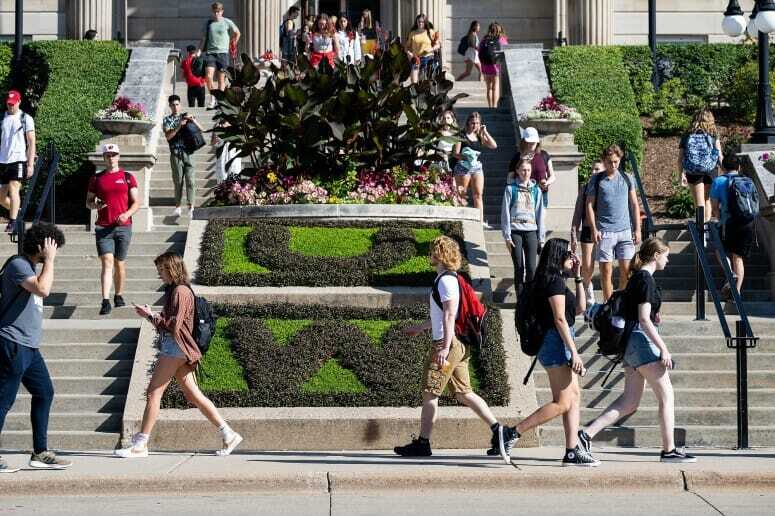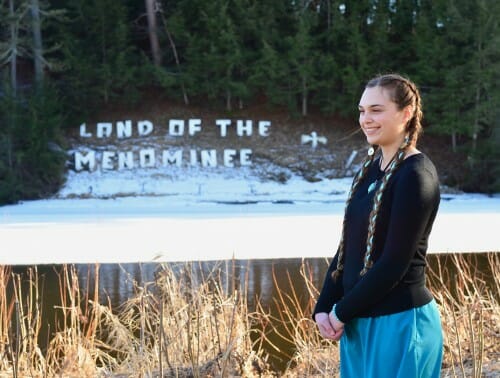UW–Madison fall enrollment reflects strong growth, ongoing commitment to Wisconsin families

Students walk past the flower bed at Agricultural Hall on the first day of class of fall semester, Sept. 7, 2022. Photo: Jeff Miller
Starting at age 7, Matthew Rilling could predict at least one gift he’d receive every Christmas: a UW–Madison sweatshirt from his grandparents.
The Rilling family really wanted a Badger, and they pinned their hopes on Matthew to be the first. He didn’t disappoint. He applied to 27 colleges and got accepted to all of them, including UW–Madison. The other 26 never really had a chance.
“Just like me, my family thinks UW–Madison is one of the best universities in the world.” says Rilling, of Omro, Wisconsin, a business major studying finance, investment and banking. “I can’t stress enough how happy I am to be here.”

Freshman Matthew Rilling is pictured in a portrait in front of Bascom Hall. Photo: Althea Dotzour
Rilling is one of 8,628 new freshmen on campus this fall. The incoming class maintains UW–Madison’s strong commitment to Wisconsin families — almost 800 of these new freshmen from Wisconsin, including Rilling, will have their tuition covered through Bucky’s Tuition Promise, now in its fifth year. The program guarantees scholarships and grants to cover tuition and segregated fees for Wisconsin resident students whose household adjusted income is $60,000 or less. Incoming freshmen receive four years of tuition, transfer students two years.
“One of the things that has most impressed me about UW–Madison is its commitment to affordability and accessibility, especially for our home state students,” says Chancellor Jennifer Mnookin, who began Aug. 4. “These are core priorities for me, so I look forward to working with the campus community to maintain crucial initiatives like Bucky’s Tuition Promise and to expand on them wherever we can.”
Increase in interest

This year’s new freshman class of 8,628 is the largest in the institution’s history, up 1.9% over last year’s class of 8,465. The university did not set out to break this record — it offered admission to almost 3,000 fewer freshman applicants this fall than the prior year. However, of those admitted, a greater percentage chose to attend UW–Madison.
The incoming freshmen were selected from a record 60,260 applicants, up 11.9% from 53,829 the prior year. Total campus enrollment is a record 49,886, up 4.1% from 47,932 last year. Enrollment figures are based on the 10th day of classes, the official student census for reporting purposes.
“We are continuing to see an increase in demand for an education at UW–Madison, which is a testament to the outstanding education and student experience offered here,” says Provost Karl Scholz. “This robust interest will help ensure that Wisconsin’s flagship university remains a key driver of economic advancement for state students and an essential provider of skilled workers for Wisconsin employers.”
Wisconsin focus
In 2015, UW–Madison committed to continue enrolling at least 3,600 Wisconsin residents in each upcoming freshman class. This year’s freshman class includes 3,787 Wisconsin resident students. This figure is especially significant given the stagnant number of Wisconsin high school graduates.
Separately, a Board of Regents enrollment policy measures UW–Madison’s commitment to the state by considering three groups of students together: Wisconsin students; Minnesota reciprocity students (who pay in-state tuition amounts); and transfer students from both states.
Under this Board of Regents policy, UW–Madison must enroll a combined minimum of 5,200 new undergraduate students from these groups each calendar year, based on a three-year rolling average. For calendar year 2022, UW–Madison exceeds this number by hundreds, enrolling 5,635 students.
Supporting college affordability
A total of 932 students new to campus this fall are receiving Bucky’s Tuition Promise — 794 are freshmen and 138 are transfer students.

D’Marion Jackson
“Financial aid was my No. 1 consideration in choosing a college, and no other school I applied to offered me something like that right off the bat,” says freshman D’Marion Jackson, a Bucky’s Tuition Promise recipient from Racine, Wisconsin. He hasn’t declared a major yet but is interested in English, psychology and social work.
The freshman class includes 1,404 students receiving need-based financial assistance through the Federal Pell Grant Program — the highest number in a freshman class to date. Pell Grants play a critical role in expanding college opportunity for students from low-income households.
Freshmen diversity
The freshman class is the most racially and ethnically diverse in the university’s history.
There are 1,431 underrepresented students of color, up from 1,251 last year. These students comprise 16.6% of the freshman class, up from 14.8% last year. Both the number and percentage of underrepresented students of color are all-time highs.
There are 2,695 new freshmen in the broader category of all students of color, up from 2,133 last year. These students comprise 31.2% of the freshman class, up from 25.2% last year. Both the number and percentage in this category are record highs.
Elise Pyatskowit, of Shawano, Wisconsin, is one new UW–Madison freshman. She identifies as white and Native American through the Menominee Indian Tribe. Pyatskowit is the recipient of a Mercile J. Lee Scholarship and hopes to become a nurse. The scholarships are designed to attract and support academically talented and outstanding individuals from underrepresented groups. Recipients receive full tuition and a $400 book stipend per semester.

Elise Pyatskowit Photo by Rich Montour
“Basically, my goal is to graduate with as little debt as possible, and this scholarship is going to help me do that,” says Pyatskowit.
International students comprise 8.6% of the new freshman class, down from 9.5% last year.
Other enrollment trends

From left, Halei Heinzel, John Baron and Akash Tayade.
About 16% of the new freshmen and 25% of new transfer students identify as first-generation students, defined as neither parent having a four-year college degree.
“To be part of UW–Madison really means something, especially if you’re like me, the first person in my family to go to college.” says Halei Heinzel, of Oconomowoc, Wisconsin, who is majoring in dairy science with hopes of becoming a veterinarian.
Heinzel grew up watching Badger hockey games and fell in love with the UW–Madison campus as a high school FFA member judging poultry at the Animal Sciences Building. She attended UW–River Falls her freshman year, then completed the Farm and Industry Short Course program at UW–Madison last year. This fall, she’s one of 1,154 new transfer students on campus, up from 1,136 last fall.
UW–Madison continues to attract students from all over the country and the world for undergraduate, graduate and professional studies. Akash Tayade, of Jalgaon, Maharashtra, India, is in his first semester at UW–Madison, pursuing a master’s degree through the Information School that focuses on data analytics.
“One of my top priorities was rankings, and UW–Madison has a good reputation in computer science,” Tayade says. “I also really like that the program I’m in requires an internship. That was appealing to me and another reason I chose UW–Madison.”
The number of graduate and professional students on campus this fall is 12,651, up from 12,458 last fall. One of those new students is John Baron, who is back on campus this fall to pursue a PhD in kinesiology after earning a master’s degree in the same field from UW–Madison in 2020.
“I had a really good experience getting my master’s degree here and knew the same could be true for a PhD,” says Baron, of Cleveland, Ohio. “UW–Madison has such a strong reputation as a high-powered research university. A degree of any sort from here carries a lot of respect and weight.”




